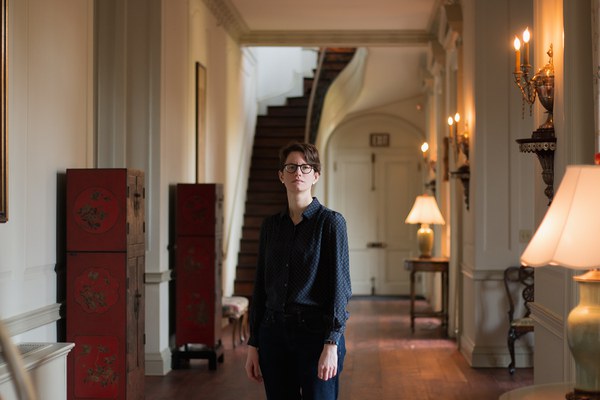Sarah Mead Leonard, a PhD candidate in art history at the University of Delaware, was a recent junior fellow in Garden and Landscape Studies. Her research report, “‘The Beauty of the Bough-Hung Banks’: William Morris in the Thames Landscape,” reconstructed the complex relationship between popular nineteenth-century designer William Morris and the English countryside.
Q&A with Sarah Mead Leonard
How did William Morris stand out from other nineteenth-century British cultural figures?
William Morris stood out for how many different things he did: he began as a poet, started designing in the 1860s, became one of the founding fathers of the UK socialist movement. In the Pre-Raphaelite circle he was running in, that combination of literature and art wasn’t uncommon—Dante Gabriel Rossetti is a famous example. But Morris added design as another element in that medieval revivalist, literary art world.
Then Morris got hugely popular. His designs tapped into the desire for historic revival, the aesthetic movement, love of plants. Because he was speaking and publishing so much, his strongly held views became very influential and were foundational for the Arts and Crafts movement. He’s stayed popular since his lifetime. His designs have been constantly available on the mass market and are enjoying another revival today, sold at H&M and seen at pretty much any museum gift shop.
Understanding Morris as a Londoner is very important for understanding the rural ideal of his designs and writing. The people before Morris—the Romantics, and Ruskin particularly, who was his very good friend—looked to the Alps, the Lake District, these wilder landscapes. They were into the sublime. Morris had no real taste for it. He went to Iceland and was overwhelmed in a somewhat negative way by the landscape. The good place for him was a riverside: controlled, calm, peaceful landscape. To him, peace was found in the pastoral.
Which makes sense considering he lived in London. London went from less than 1 million people at the beginning of the century to over 6 million by 1900. It was the biggest city the world had ever known by the 1850s, fueled by the rapid rise of technology. The huge expansion of the urban environment, and related problems like pollution and disease, had not been seen on that scale in Western Europe. London took the sense of the terrifying sublime to another level. If you were reacting against that, you might not want to go look at an Alp.
A lot of people turned to the past in this period, just like people do in any era, trying to find an alternative to a present they don’t enjoy. To Morris, the British countryside became that alternative. He was looking at medieval stories and places that reminded him of his childhood running around in the river valleys and forest northeast of London. The countryside landscape got channeled into everything he did, from his earliest known poem about willow trees to, I argue, his designs.
What discovery did you make about Morris’s designs while at Dumbarton Oaks?
I was grappling with the blue-on-white backdrops of Morris’s later tributary patterns. Generally, by looking at his statements and patterns, you can often say, well there are some willows, there’s an iris. But these background designs are more abstract white five-lobed flowers. At first I thought you couldn’t say much about them botanically because a million plants like these exist. Then I came across a photo of an aquatic plant called water crowfoot. And I said, that’s it. I argue that the blue backdrop can be read as water and the mid-ground botanical form can actually be read as this aquatic plant. Water crowfoot is a plant Morris absolutely would have seen growing in streams like the Kennet where he spent time and after which those later patterns were named.
How does your work explore the cultural histories of plants, a theme of the Plant Humanities Initiative?
I was so excited to hear about the Plant Humanities Initiative because I’ve always been interested in how plants show up in culture. The guest lectures have been incredibly eye-opening. The talk on leaf architecture from New York Botanical Garden scientists suggested new angles for me for journal articles, particularly applying these kinds of scientific models—taxonomies, structure—to arts and humanities research.
Morris looked at nature very closely. The patterns reflect his observation of the way things grew around him. For example, I argue the density of botanical motifs relates to the multilayering of different types of plants in hedgerows. To understand this art, we need to look to the physical landscape—and we need to look at the plants. Sometimes that is a disconnect. Landscape studies often focuses on how people shape landscape, but it doesn’t necessarily get down to the nitty gritty of how people are interacting with the plants, how the plants are influencing the people. Morris has given me a wonderful opportunity to bridge that gap.
Julia Ostmann is postgraduate writing and reporting fellow at Dumbarton Oaks. Photo by Elizabeth Muñoz Huber, postgraduate digital media fellow.

